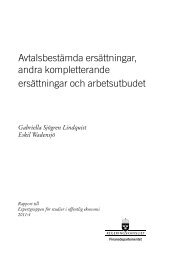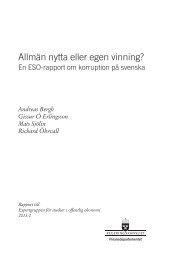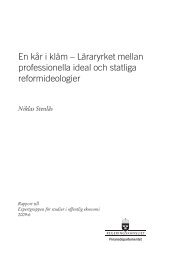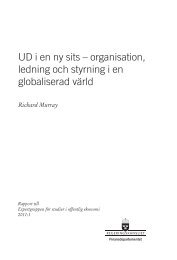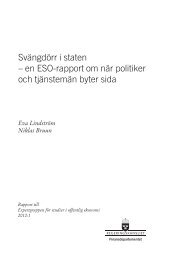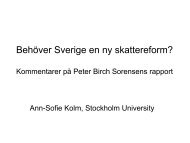Läs rapporten här - Expertgruppen för Studier i Offentlig ekonomi
Läs rapporten här - Expertgruppen för Studier i Offentlig ekonomi
Läs rapporten här - Expertgruppen för Studier i Offentlig ekonomi
Create successful ePaper yourself
Turn your PDF publications into a flip-book with our unique Google optimized e-Paper software.
Summary 2012:5<br />
Metro not materialized. The current Metro produces about the<br />
same socioeconomic benefits assuming the simulated land-use<br />
pattern as it produces in the existing land-use patterns that to a<br />
large extent has adapted to the Metro. This is because the simulated<br />
land-use pattern is considerably denser than the current, since the<br />
benefit of a central high capacity public transport infrastructure is<br />
generally large in dense settlement pattern.<br />
The result of the land-use simulation indicates, hence, that<br />
Stockholm has developed into a sparser and less dense region than<br />
what the market forces would have steered towards. A<br />
consequence of the investment in the Metro was that new<br />
settlements were planned far from the city center when the Metro<br />
was built. However, there is a high demand for living in the dense<br />
inner city or the semi-central suburbs, and higher density thus<br />
could have been the result had land-use been governed by market<br />
forces. Our analysis suggests that the reason for Stockholm not<br />
currently being denser is primarily a supply problem; new houses<br />
have not been produced in central locations to the extent that it has<br />
been a demand for. It should be stressed, however, that land-use<br />
development is ruled by a complicated course of events and<br />
mechanisms. The land-use simulation thus contains large<br />
uncertainties.<br />
The present analysis demonstrates that settlement patterns<br />
planned for along tracks far out from the city center increases<br />
travel distances and even energy consumption compared to a<br />
denser land-use patterns. In the specific relations to and from the<br />
inner city the Metro provides effective and energy efficient<br />
transport, primarily for commuting. But the sparse settlement<br />
pattern also give rise to long distances and higher proportion of car<br />
travel especially for other trip purposes in other relations than<br />
to/from the city center. Settlements along the Metro corridor far<br />
from the center seem thus to have fueled a trend of increasing trip<br />
distances and thus weakened the competitiveness of bicycle and<br />
public transport particularly in other trip relations than to/from<br />
the city.<br />
If comparing the energy consumption (measured as mileage of<br />
car traffic) in the two different land use scenarios, the current and<br />
the simulated, the analysis shows that energy consumption is 13<br />
percent lower in the simulated land use than in the current land use<br />
(assuming that the Metro is built in both scenarios). Meanwhile,<br />
energy consumption is 6 percent higher if the Metro is replaced<br />
16



